warning Mercury Mountaineer 2004 s Service Manual
[x] Cancel search | Manufacturer: MERCURY, Model Year: 2004, Model line: Mountaineer, Model: Mercury Mountaineer 2004Pages: 280, PDF Size: 5.38 MB
Page 244 of 280
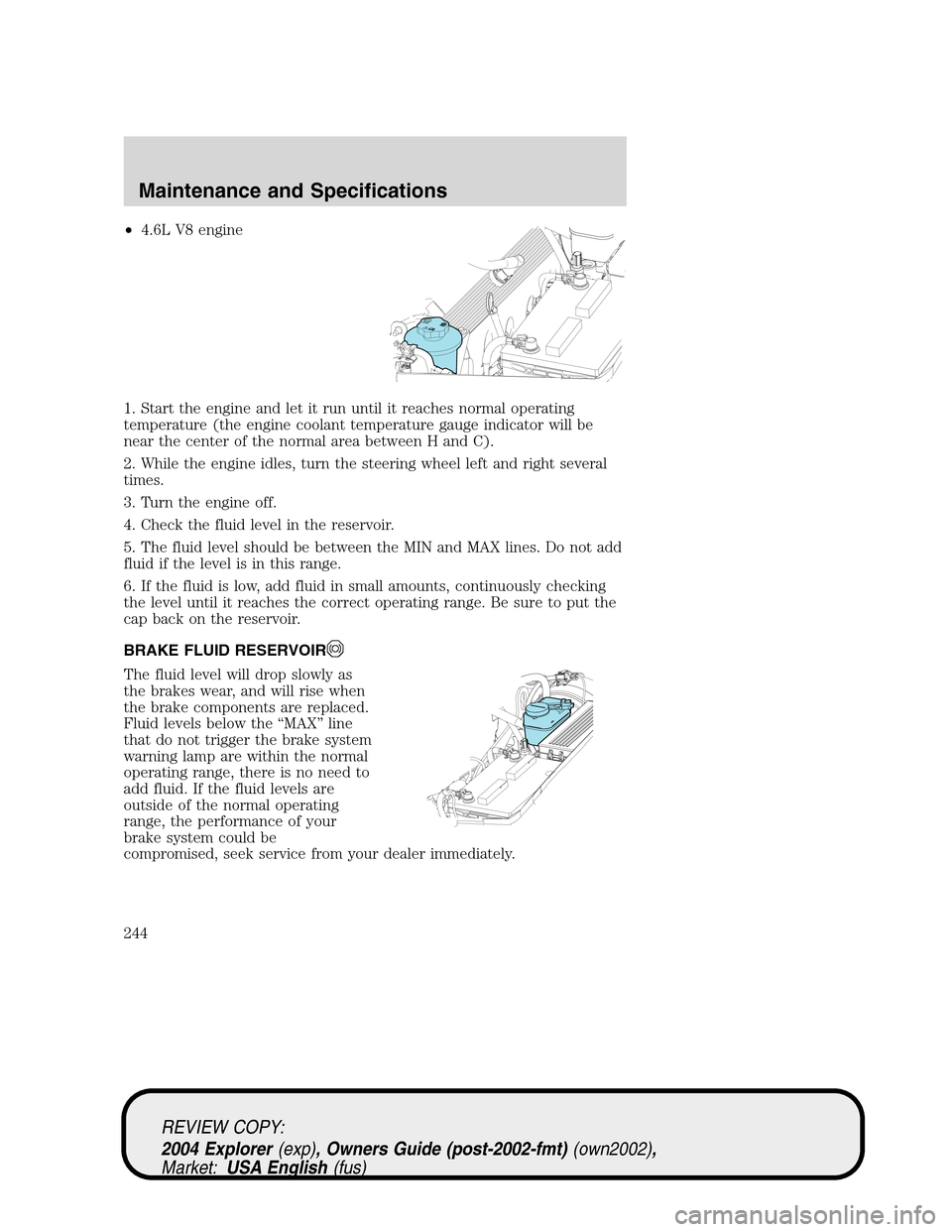
•4.6L V8 engine
1. Start the engine and let it run until it reaches normal operating
temperature (the engine coolant temperature gauge indicator will be
near the center of the normal area between H and C).
2. While the engine idles, turn the steering wheel left and right several
times.
3. Turn the engine off.
4. Check the fluid level in the reservoir.
5. The fluid level should be between the MIN and MAX lines. Do not add
fluid if the level is in this range.
6. If the fluid is low, add fluid in small amounts, continuously checking
the level until it reaches the correct operating range. Be sure to put the
cap back on the reservoir.
BRAKE FLUID RESERVOIR
The fluid level will drop slowly as
the brakes wear, and will rise when
the brake components are replaced.
Fluid levels below the “MAX” line
that do not trigger the brake system
warning lamp are within the normal
operating range, there is no need to
add fluid. If the fluid levels are
outside of the normal operating
range, the performance of your
brake system could be
compromised, seek service from your dealer immediately.
REVIEW COPY:
2004 Explorer(exp), Owners Guide (post-2002-fmt)(own2002),
Market:USA English(fus)
Maintenance and Specifications
244
Page 251 of 280

12.Treadwear, Traction and Temperature Grades
•Treadwear:The treadwear grade is a comparative rating based on the
wear rate of the tire when tested under controlled conditions on a
specified government test course. For example, a tire graded 150
would wear one and one-half (1
1�2) times as well on the government
course as a tire graded 100.
•Traction:The traction grades, from highest to lowest are AA, A, B,
and C. The grades represent the tire’s ability to stop on wet pavement
as measured under controlled conditions on specified government test
surfaces of asphalt and concrete. A tire marked C may have poor
traction performance.
•Temperature:The temperature grades are A (the highest), B and C,
representing the tire’s resistance to the generation of heat and its
ability to dissipate heat when tested under controlled conditions on a
specified indoor laboratory test wheel.
13.Maximum Permissible Inflation Pressure:Tire manufactures
maximum permissible pressure and/or the pressure at which the
maximum load can be carried by the tire. This pressure is normally
higher than the manufacturer’s recommended cold inflation pressure
which can be found on either the tire label or certification label which is
located on the structure by the trailing edge of the driver’s door or the
edge of the driver’s door. The cold inflation pressure should never be set
lower than the recommended pressure on the vehicle label.
The tire suppliers may have additional markings, notes or warnings such
as standard load, radial tubeless, etc.
REVIEW COPY:
2004 Explorer(exp), Owners Guide (post-2002-fmt)(own2002),
Market:USA English(fus)
Maintenance and Specifications
251
Page 259 of 280

Never spin the tires in excess of the 35 mph (55 km/h) point
indicated on the speedometer.
Highway hazards
No matter how carefully you drive there’s always the possibility that you
may eventually have a flat tire on the highway. Drive slowly to the
closest safe area out of traffic. This may further damage the flat tire, but
your safety is more important.
If you feel a sudden vibration or ride disturbance while driving, or you
suspect your tire or vehicle has been damaged, immediately reduce your
speed. Drive with caution until you can safely pull off the road. Stop and
inspect the tires for damage. If a tire is under-inflated or damaged,
deflate it, remove wheel and replace it with your spare tire and wheel. If
you cannot detect a cause, have the vehicle towed to the nearest repair
facility or tire dealer to have the vehicle inspected.
Tire pressure monitoring system (TPMS)(if equipped)
When the tire pressure monitoring
system warning light is lit, one or
more of your tires is significantly
under-inflated. You should stop and
check your tires as soon as possible,
and inflate them to the proper pressure as indicated on the vehicle’s tire
information placard (label). Driving on a significantly under-inflated tire
causes the tire to overheat and can lead to tire failure. Under-inflation
also reduces fuel efficiency and tire tread life, and may affect the
vehicle’s handling and stopping ability. Even if your vehicle is equipped
with a tire pressure monitoring system, it is still important that you
manually check the inflation pressure of your tires regularly. Each tire,
including the spare, should be checked monthly when cold and set to the
recommended inflation pressure as specified on the vehicle placard
(label) and in the owner’s manual.
Note:The Tire Pressure Monitoring System (TPMS) monitors tire
pressure in each pneumatic tire. The pressure in each tire is dependent
upon several factors, one of them being the contained air temperature
(temperature of the air inside the tire). As the contained air temperature
increases, the tire pressure also increases. While driving in a normal
manner, a typical passenger tire inflation pressure may increase
approximately 2 to 4 psi (14 to 28 kPa) from a cold start situation. This
increase in tire pressure is due to an increase in the contained air
REVIEW COPY:
2004 Explorer(exp), Owners Guide (post-2002-fmt)(own2002),
Market:USA English(fus)
Maintenance and Specifications
259
Page 260 of 280

temperature. Contained air temperature is dependent upon several
factors such as rate of tire rotation, tire deflection, amount of braking,
etc. In similar manner, the tire pressure will decrease if the contained air
temperature decreases. For example, if the vehicle is stationary over
night with the outside temperature significantly lower than the daytime
temperature, the tire pressure may decrease approximately 3 psi (20.7
kPa) for a drop of 30° F (16.6° C) in ambient temperature. This lower
pressure value may be detected by the TPMS as being significantly lower
than the cold pressure indicated on your vehicles tire label, and activate
the TPMS warning for low tire pressure. If the low warning light is on,
visually check each tire to verify that no tire is flat. If one or more tires
are flat, repair of fix as necessary. If all tires appear to be inflated,
carefully drive the vehicle to the nearest location where air can be added
to the tires. Turn the ignition to the “off” position. Inflate all the tires to
the recommended cold pressure.
The system uses radio-frequency to monitor the tire pressure on all tires
excluding the spare tire. The sensors transmit the tire pressure readings
to the receiver module located in the vehicle. The receiver module then
electronically transmits the status to the message center. For more tire
warning information, refer to theMessage Centerin theDriver controls
chapter.
This device complies with part 15 of the FCC rules and with RS-210 of
Industry Canada. Operation is subject to the following two conditions:
(1) This device may not cause harmful interference, and (2) This device
must accept any interference received, including interference that may
cause undesired operation.
The tire pressure monitoring system is NOT a substitute for
manually checking tire pressure. The tire pressure should be
checked periodically (at least monthly) using a tire gauge, seeTire
inflation pressurein this chapter. Failure to properly maintain your
tire pressure could increase the risk of tire failure, loss of control,
vehicle rollover and personal injury.
REVIEW COPY:
2004 Explorer(exp), Owners Guide (post-2002-fmt)(own2002),
Market:USA English(fus)
Maintenance and Specifications
260
Page 274 of 280
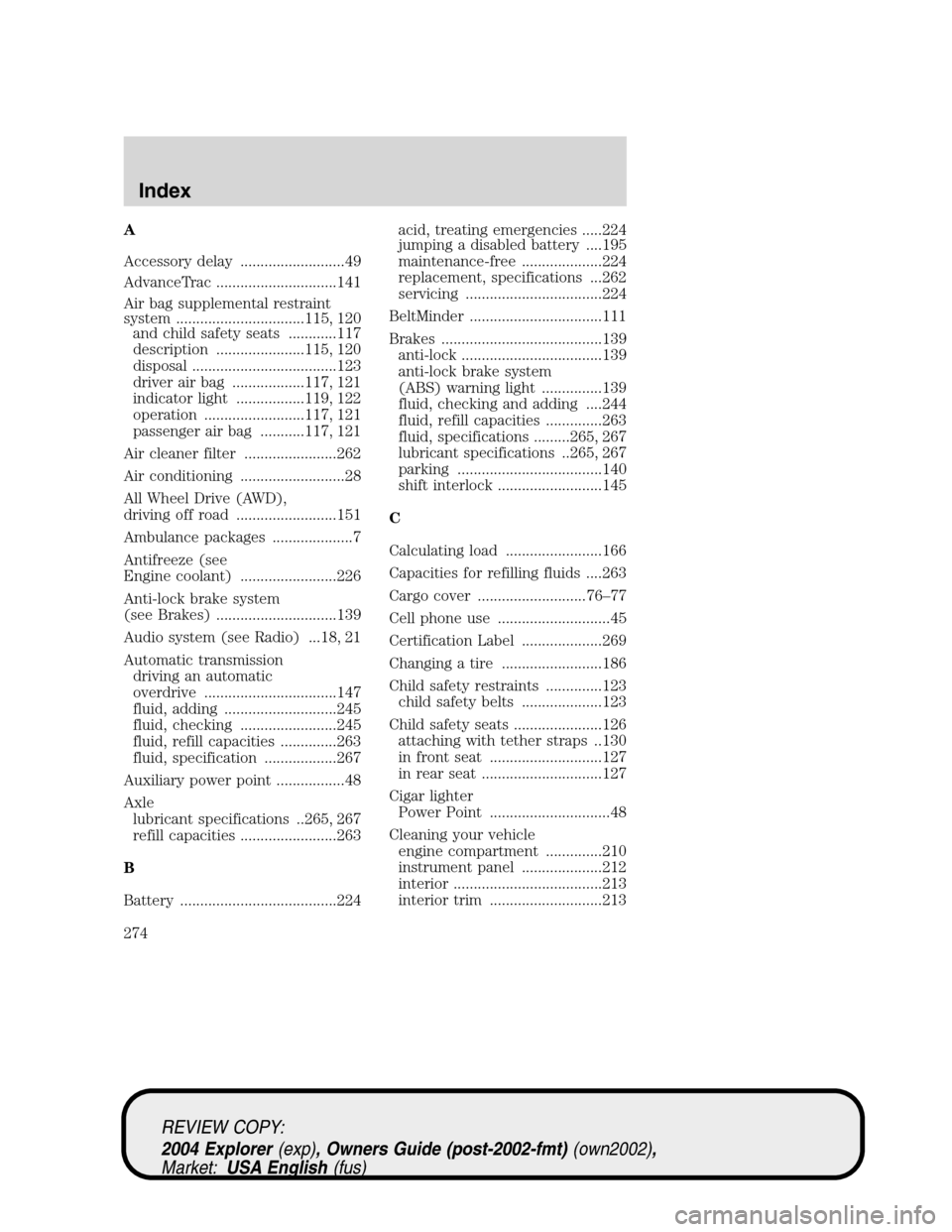
A
Accessory delay ..........................49
AdvanceTrac ..............................141
Air bag supplemental restraint
system ................................115, 120
and child safety seats ............117
description ......................115, 120
disposal ....................................123
driver air bag ..................117, 121
indicator light .................119, 122
operation .........................117, 121
passenger air bag ...........117, 121
Air cleaner filter .......................262
Air conditioning ..........................28
All Wheel Drive (AWD),
driving off road .........................151
Ambulance packages ....................7
Antifreeze (see
Engine coolant) ........................226
Anti-lock brake system
(see Brakes) ..............................139
Audio system (see Radio) ...18, 21
Automatic transmission
driving an automatic
overdrive .................................147
fluid, adding ............................245
fluid, checking ........................245
fluid, refill capacities ..............263
fluid, specification ..................267
Auxiliary power point .................48
Axle
lubricant specifications ..265, 267
refill capacities ........................263
B
Battery .......................................224acid, treating emergencies .....224
jumping a disabled battery ....195
maintenance-free ....................224
replacement, specifications ...262
servicing ..................................224
BeltMinder .................................111
Brakes ........................................139
anti-lock ...................................139
anti-lock brake system
(ABS) warning light ...............139
fluid, checking and adding ....244
fluid, refill capacities ..............263
fluid, specifications .........265, 267
lubricant specifications ..265, 267
parking ....................................140
shift interlock ..........................145
C
Calculating load ........................166
Capacities for refilling fluids ....263
Cargo cover ...........................76–77
Cell phone use ............................45
Certification Label ....................269
Changing a tire .........................186
Child safety restraints ..............123
child safety belts ....................123
Child safety seats ......................126
attaching with tether straps ..130
in front seat ............................127
in rear seat ..............................127
Cigar lighter
Power Point ..............................48
Cleaning your vehicle
engine compartment ..............210
instrument panel ....................212
interior .....................................213
interior trim ............................213
REVIEW COPY:
2004 Explorer(exp), Owners Guide (post-2002-fmt)(own2002),
Market:USA English(fus)
Index
Index
274
Page 277 of 280
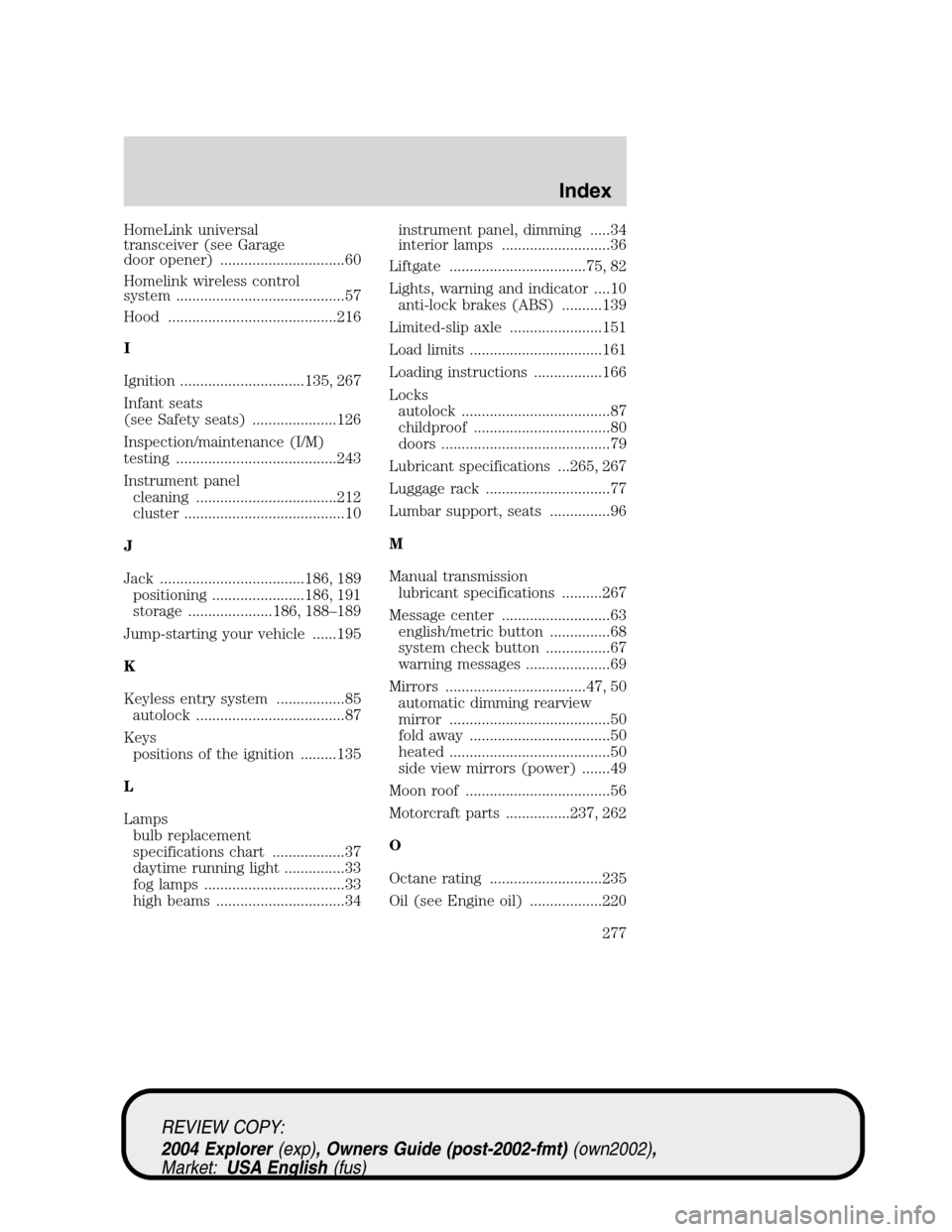
HomeLink universal
transceiver (see Garage
door opener) ...............................60
Homelink wireless control
system ..........................................57
Hood ..........................................216
I
Ignition ...............................135, 267
Infant seats
(see Safety seats) .....................126
Inspection/maintenance (I/M)
testing ........................................243
Instrument panel
cleaning ...................................212
cluster ........................................10
J
Jack ....................................186, 189
positioning .......................186, 191
storage .....................186, 188–189
Jump-starting your vehicle ......195
K
Keyless entry system .................85
autolock .....................................87
Keys
positions of the ignition .........135
L
Lamps
bulb replacement
specifications chart ..................37
daytime running light ...............33
fog lamps ...................................33
high beams ................................34instrument panel, dimming .....34
interior lamps ...........................36
Liftgate ..................................75, 82
Lights, warning and indicator ....10
anti-lock brakes (ABS) ..........139
Limited-slip axle .......................151
Load limits .................................161
Loading instructions .................166
Locks
autolock .....................................87
childproof ..................................80
doors ..........................................79
Lubricant specifications ...265, 267
Luggage rack ...............................77
Lumbar support, seats ...............96
M
Manual transmission
lubricant specifications ..........267
Message center ...........................63
english/metric button ...............68
system check button ................67
warning messages .....................69
Mirrors ...................................47, 50
automatic dimming rearview
mirror ........................................50
fold away ...................................50
heated ........................................50
side view mirrors (power) .......49
Moon roof ....................................56
Motorcraft parts ................237, 262
O
Octane rating ............................235
Oil (see Engine oil) ..................220
REVIEW COPY:
2004 Explorer(exp), Owners Guide (post-2002-fmt)(own2002),
Market:USA English(fus)
Index
277
Page 278 of 280
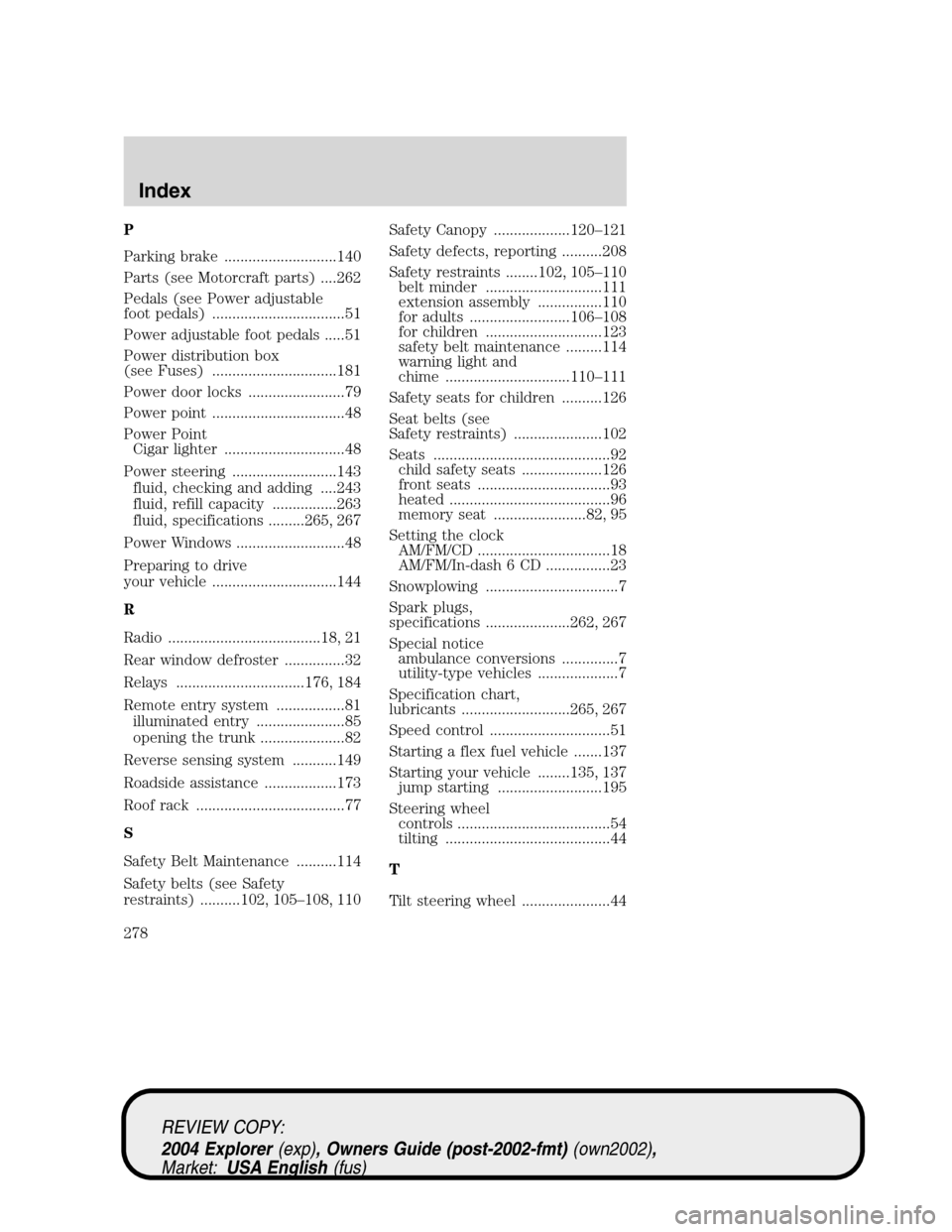
P
Parking brake ............................140
Parts (see Motorcraft parts) ....262
Pedals (see Power adjustable
foot pedals) .................................51
Power adjustable foot pedals .....51
Power distribution box
(see Fuses) ...............................181
Power door locks ........................79
Power point .................................48
Power Point
Cigar lighter ..............................48
Power steering ..........................143
fluid, checking and adding ....243
fluid, refill capacity ................263
fluid, specifications .........265, 267
Power Windows ...........................48
Preparing to drive
your vehicle ...............................144
R
Radio ......................................18, 21
Rear window defroster ...............32
Relays ................................176, 184
Remote entry system .................81
illuminated entry ......................85
opening the trunk .....................82
Reverse sensing system ...........149
Roadside assistance ..................173
Roof rack .....................................77
S
Safety Belt Maintenance ..........114
Safety belts (see Safety
restraints) ..........102, 105–108, 110Safety Canopy ...................120–121
Safety defects, reporting ..........208
Safety restraints ........102, 105–110
belt minder .............................111
extension assembly ................110
for adults .........................106–108
for children .............................123
safety belt maintenance .........114
warning light and
chime ...............................110–111
Safety seats for children ..........126
Seat belts (see
Safety restraints) ......................102
Seats ............................................92
child safety seats ....................126
front seats .................................93
heated ........................................96
memory seat .......................82, 95
Setting the clock
AM/FM/CD .................................18
AM/FM/In-dash 6 CD ................23
Snowplowing .................................7
Spark plugs,
specifications .....................262, 267
Special notice
ambulance conversions ..............7
utility-type vehicles ....................7
Specification chart,
lubricants ...........................265, 267
Speed control ..............................51
Starting a flex fuel vehicle .......137
Starting your vehicle ........135, 137
jump starting ..........................195
Steering wheel
controls ......................................54
tilting .........................................44
T
Tilt steering wheel ......................44
REVIEW COPY:
2004 Explorer(exp), Owners Guide (post-2002-fmt)(own2002),
Market:USA English(fus)
Index
278
Page 279 of 280
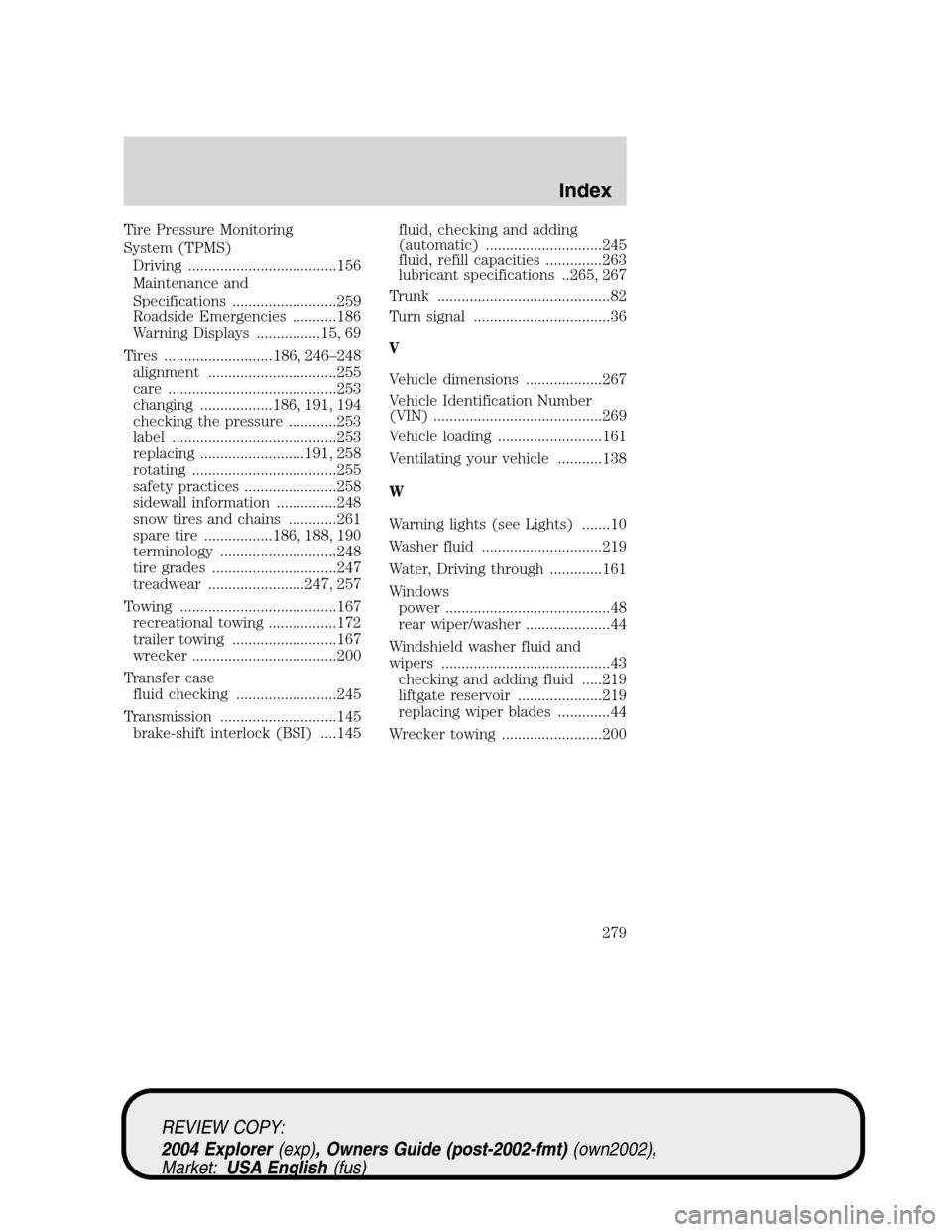
Tire Pressure Monitoring
System (TPMS)
Driving .....................................156
Maintenance and
Specifications ..........................259
Roadside Emergencies ...........186
Warning Displays ................15, 69
Tires ...........................186, 246–248
alignment ................................255
care ..........................................253
changing ..................186, 191, 194
checking the pressure ............253
label .........................................253
replacing ..........................191, 258
rotating ....................................255
safety practices .......................258
sidewall information ...............248
snow tires and chains ............261
spare tire .................186, 188, 190
terminology .............................248
tire grades ...............................247
treadwear ........................247, 257
Towing .......................................167
recreational towing .................172
trailer towing ..........................167
wrecker ....................................200
Transfer case
fluid checking .........................245
Transmission .............................145
brake-shift interlock (BSI) ....145fluid, checking and adding
(automatic) .............................245
fluid, refill capacities ..............263
lubricant specifications ..265, 267
Trunk ...........................................82
Turn signal ..................................36
V
Vehicle dimensions ...................267
Vehicle Identification Number
(VIN) ..........................................269
Vehicle loading ..........................161
Ventilating your vehicle ...........138
W
Warning lights (see Lights) .......10
Washer fluid ..............................219
Water, Driving through .............161
Windows
power .........................................48
rear wiper/washer .....................44
Windshield washer fluid and
wipers ..........................................43
checking and adding fluid .....219
liftgate reservoir .....................219
replacing wiper blades .............44
Wrecker towing .........................200
REVIEW COPY:
2004 Explorer(exp), Owners Guide (post-2002-fmt)(own2002),
Market:USA English(fus)
Index
279